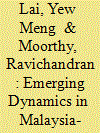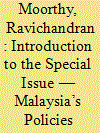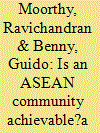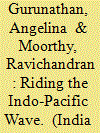|
|
|
Sort Order |
|
|
|
Items / Page
|
|
|
|
|
|
|
| Srl | Item |
| 1 |
ID:
123005


|
|
|
|
|
| Publication |
2013.
|
| Summary/Abstract |
Scholars have remarked that the decision-making process in the Association of Southeast Asian Nations (ASEAN) is largely elitist in nature and concentrated within the higher echelon of leadership, with little public participation. Since ASEAN is moving toward community building by the year 2015, questions arise on whether the people are consulted, aware, and support this initiative - which is the focus of this article. The authors argue that increased awareness and knowledge of the public regarding the ASEAN Community initiative will eventually translate into increased support. Against this background, this article analyzes the extent the public in Indonesia, Malaysia, and Singapore are aware of and support the proposed initiative, based on public opinion surveys conducted by the authors in these countries. To support the discussion, this article also employs the Pearson chi-square test to analyze the relationship between public awareness and support for the ASEAN Community.
|
|
|
|
|
|
|
|
|
|
|
|
|
|
|
|
| 2 |
ID:
185901


|
|
|
|
|
| Summary/Abstract |
Japan and Malaysia established relations in 1957, the year Malaysia obtained independence from the British. Malaysia has largely benefited through many Japanese assistance programs, and in return, the country has remained one of Japan’s closest friends in Southeast Asia. During his first premiership, Mahathir introduced the Look East Policy (LEP) as a major foreign policy re-direction, moving away from the Western approach adopted by his predecessors. Nevertheless, bilateral relations plateaued during the reign of the two successive prime ministers Abdullah Badawi and Najib Razak primarily as a result of the changing regional geopolitical landscape. Malaysia moved closer towards an emerging China. However, the May 2018 general election paved the way for Mahathir to resume control of the country for the second time after a lapse of 15 years. Within less than a year, Japan started to bounce back in Malaysia’s political and strategic sensors. Japan is set to play a greater role in the Malaysian economic landscape, especially with its assistance of low-interest samurai bonds to aid the debt-stricken new Malaysian government. For Japan, this rekindling of old friendship could not have been more timely and may translate into greater support to Japan’s initiatives for regional peace and for a free and open Indo-Pacific region. This paper examines the evolving trends in bilateral relations between Japan and Malaysia in the second Mahathir administration. More specifically, it explicates the external and domestic sources which have affected and recalibrated Malaysia’s Japan policy in the context of a shifting regional strategic milieu as well as an evolving post-election domestic political landscape. This paper contends that the emerging dynamics and trajectories in Malaysia’s relations with Japan under the nascent “Mahathirism 2.0” period have been primarily shaped by the country’s ruling elite’s perceptions of her external conditions in the context of East Asia’s changing power dynamics, tempered by their domestic political considerations and leadership traits/idiosyncrasies. It further argues that despite the newly-minted Pakatan Harapan (PH) government’s visible foreign policy adjustments indicating a possible shift of emphasis from China towards Japan, such recalibrations are yet to alter the fundamentals of Malaysia’s Northeast Asia policy generally and its Japan policy specifically, an area in which the effects of structural conditions (proximity, power asymmetry, rivalries and uncertainties) continue to be informed by the Malaysian ruling elite’s domestic political considerations as they strive as much to optimize the country’s external interests as to consolidate their domestic legitimation.
|
|
|
|
|
|
|
|
|
|
|
|
|
|
|
|
| 3 |
ID:
185899


|
|
|
| 4 |
ID:
117654


|
|
|
|
|
| Publication |
2012.
|
| Summary/Abstract |
The formulation "ASEAN Community" has been criticized for being too elitist and lacking serious efforts to solicit public opinion. This article examines how the people in Indonesia, Malaysia, and Singapore view the concept of "community building" and the obstacles this initiative may encounter.
|
|
|
|
|
|
|
|
|
|
|
|
|
|
|
|
| 5 |
ID:
182608


|
|
|
|
|
| Summary/Abstract |
India and the Association of Southeast Asian Nations’ (ASEAN) partnership began in the early 1990s mainly in the economic domain. Reeling from a major internal crisis, India wanted to tap onto the region’s economic vibrancy to strengthen its own waning economy. Since then, amidst India’s domestic constraints, economic ties have largely sustained the India–ASEAN partnership on a steady course. India’s withdrawal from the ASEAN-led Regional Comprehensive Economic Partnership (RCEP) negotiations in 2019, therefore, was an important inflection point in the partnership. This study, hence, discusses the prospects for the India–ASEAN partnership moving forward beyond the RCEP. This is undertaken by first examining the main challenges India faces with the ASEAN Free Trade Arrangement and the RCEP. After which, relevant developments pertaining to India’s multilateral partnership within the Indo-Pacific theatre as well as to India’s economic trajectory are deliberated in relation to ASEAN. Based on this analysis, this study argues that the outlook for India–ASEAN ties remains optimistic since the external and internal pressures needed for important economic reforms has not diminished for India. In addition, there are prospects for wider engagements with ASEAN due to Indo-Pacific-related strategic recalibrations in the region. Therefore, collectively these factors will provide crucial thrusts for the partnership to move forward strongly sans RCEP.
|
|
|
|
|
|
|
|
|
|
|
|
|
|
|
|
|
|
|
|
|